As posted in The Gaston Gazette:
(2/22/15) BELMONT, N.C. – Fundraising effectively for your cause or your nonprofit may seem like a deceptively simple enterprise. After the recent success of the ALS ice bucket challenge – which, according to Forbes, raised well above $100 million after it spread like wildfire on social media last year – savvy observers are trying to determine how their cause can become the next viral phenomenon.
But fundraising in spectacular fashion is a rarity. What’s more achievable – and more sustainable long-term – is learning to communicate your message to potential donors in ways that earn their devotion to your cause year after year. Here are a few ways that you can make progress toward that goal:
- Tell dramatic, engaging, specific stories. If you want donor dollars, you need to tell stories they can’t resist. The Wheel, a support and representation network for Irish community and charitable organizations, says there are six kinds of effective fundraising stories, from the “nature of our challenge” story to the “where we are going” story. What makes them truly successful is their specificity. Consider, for example, the American Red Cross: the organization’s national website features a “Stories” tab, where donors can read about individuals who have received help. The ability of these stories to dramatize need, to put a face on where funds go and to remind donors that an organization is a collection of impassioned individuals is what makes them powerful – and helps them to bring in consistent funding.
- Keep it simple and consistent across all platforms. Campaigns like the ALS ice bucket challenge are considered by many to be admirable, but unachievable. What any cause can take away from that campaign are the ideas of simplicity and consistency. That campaign had one focus, and it stuck to that focus. What worked well was the fun challenge to potential donors, but also the simple, relatable message. You can model your own communications on this same principle. Keep your message short and focused – what information is essential? Make the message urgent – why do you need donor dollars now and not later? And make your message clear, using simple, approachable language. Then be sure to replicate that message across all of your communication mediums, including your website, social media, newsletters and fundraising speeches. Simple, consistent communications go a long way to securing donor confidence and support.
- Develop donor handles. While it’s great to tell the story of your organization’s inception or what you hope to achieve, the best way to keep donors’ attention long-term is to make your donors themselves an integral part of your organization’s story. Although the stories mentioned previously are valuable, the most important story you’ll tell is the one that explains and encourages donor involvement. Integrate your donors into your organization’s story whenever possible: clearly illustrate how their dollars will be used to make a difference. For example, Holy Angels in Belmont, N.C., clearly designates how donor dollars are used to support its cause: the website lists donation amounts from $25, which purchases “a set of specialized eating utensils and plates,” through $12,000, which funds a new wheelchair. If you continue to find consistent ways to give donors the flexibility to determine how their dollars can help your cause, the more likely it will be that those dollars keep rolling in.
- Show where the money goes – and link your call to current needs. Every person who donates to a cause or organization wants to know how his or her money is being spent. Although charts and graphs can be helpful for board of directors’ meetings and annual reports, they don’t always appeal to a donor’s heart. Whenever possible, give donors the option of donating to a specific cause or campaign within your organization. And whenever possible, reiterate the urgency of your need for donations. Make sure your organization is staying abreast of the needs of your overall cause and its local concerns, which will keep your organization timely and relevant – both characteristics that donors highly value.
- Don’t forget the personal touch. An elegant website or a fancy newsletter is eye-catching, but what matters more is that your donors feel that their time, money, and personal beliefs and values are respected and appreciated. The best way to express that is also one of the most timeless: using personalized communication. When you interact with a new donor, try to gather a little personal information about them so you can note it in future correspondence. Some organizations may be able to pen a handwritten thank-you note; timely phone calls from volunteer leadership and staff are also important. Every communication, however, should address the donor by name and should include a signature from an organization representative. Remember your donors during the holidays and, whenever possible, on their birthdays as well. A good rule of thumb is to create opportunities to thank your major donors seven times a year. If your funds are limited, write a thoughtful, heartfelt note. When you can, send a small gift or hold a thank-you event. Regardless, what’s most important is that you regularly thank the people who are making your work possible and that you remember them by name.
Although it takes time to become masterful at fundraising communications, with a little time and effort, you’ll be well on your way to having donors clamoring for a chance to help out your cause – instead of you clamoring for their attention.
Lyerly Agency’s President and CEO Elaine Lyerly and Executive Vice President and COO Melia Lyerly share their 35+ years of marketing, advertising, public relations and brand strategy experience with readers each month in a column published by The Gaston Gazette. See this month’s edition at http://bit.ly/1BJlEhD.
